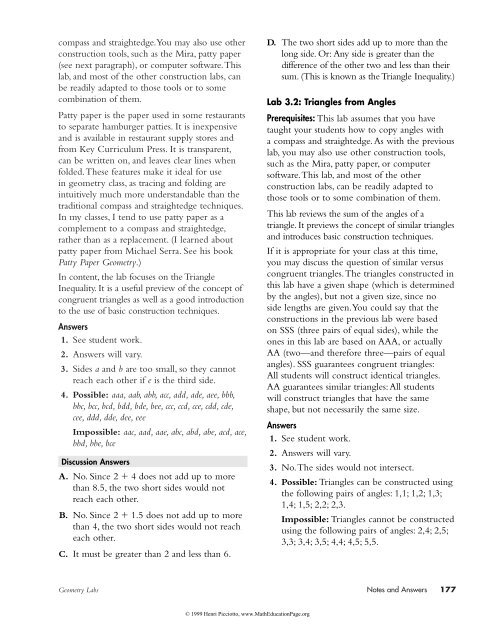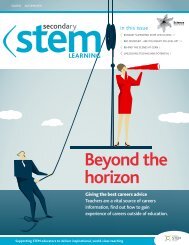Create successful ePaper yourself
Turn your PDF publications into a flip-book with our unique Google optimized e-Paper software.
compass and straightedge.You may also use other<br />
construction tools, such as the Mira, patty paper<br />
(see next paragraph), or computer software.This<br />
lab, and most of the other construction <strong>labs</strong>, can<br />
be readily adapted to those tools or to some<br />
combination of them.<br />
Patty paper is the paper used in some restaurants<br />
to separate hamburger patties. It is inexpensive<br />
and is available in restaurant supply stores and<br />
from Key Curriculum Press. It is transparent,<br />
can be written on, and leaves clear lines when<br />
folded.These features make it ideal for use<br />
in <strong>geometry</strong> class, as tracing and folding are<br />
intuitively much more understandable than the<br />
traditional compass and straightedge techniques.<br />
In my classes, I tend to use patty paper as a<br />
complement to a compass and straightedge,<br />
rather than as a replacement. (I learned about<br />
patty paper from Michael Serra. See his book<br />
Patty Paper Geometry.)<br />
In content, the lab focuses on the Triangle<br />
Inequality. It is a useful preview of the concept of<br />
congruent triangles as well as a good introduction<br />
to the use of basic construction techniques.<br />
Answers<br />
1. See student work.<br />
2. Answers will vary.<br />
3. Sides a and b are too small, so they cannot<br />
reach each other if e is the third side.<br />
4. Possible: aaa, aab, abb, acc, add, ade, aee, bbb,<br />
bbc, bcc, bcd, bdd, bde, bee, ccc, ccd, cce, cdd, cde,<br />
cee, ddd, dde, dee, eee<br />
Impossible: aac, aad, aae, abc, abd, abe, acd, ace,<br />
bbd, bbe, bce<br />
Discussion Answers<br />
A. No. Since 2 4 does not add up to more<br />
than 8.5, the two short sides would not<br />
reach each other.<br />
B. No. Since 2 1.5 does not add up to more<br />
than 4, the two short sides would not reach<br />
each other.<br />
C. It must be greater than 2 and less than 6.<br />
D. The two short sides add up to more than the<br />
long side. Or: Any side is greater than the<br />
difference of the other two and less than their<br />
sum. (This is known as the Triangle Inequality.)<br />
Lab 3.2: Triangles from Angles<br />
Prerequisites: This lab assumes that you have<br />
taught your students how to copy angles with<br />
a compass and straightedge. As with the previous<br />
lab, you may also use other construction tools,<br />
such as the Mira, patty paper, or computer<br />
software.This lab, and most of the other<br />
construction <strong>labs</strong>, can be readily adapted to<br />
those tools or to some combination of them.<br />
This lab reviews the sum of the angles of a<br />
triangle. It previews the concept of similar triangles<br />
and introduces basic construction techniques.<br />
If it is appropriate for your class at this time,<br />
you may discuss the question of similar versus<br />
congruent triangles.The triangles constructed in<br />
this lab have a given shape (which is determined<br />
by the angles), but not a given size, since no<br />
side lengths are given.You could say that the<br />
constructions in the previous lab were based<br />
on SSS (three pairs of equal sides), while the<br />
ones in this lab are based on AAA, or actually<br />
AA (two—and therefore three—pairs of equal<br />
angles). SSS guarantees congruent triangles:<br />
All students will construct identical triangles.<br />
AA guarantees similar triangles: All students<br />
will construct triangles that have the same<br />
shape, but not necessarily the same size.<br />
Answers<br />
1. See student work.<br />
2. Answers will vary.<br />
3. No.The sides would not intersect.<br />
4. Possible: Triangles can be constructed using<br />
the following pairs of angles: 1,1; 1,2; 1,3;<br />
1,4; 1,5; 2,2; 2,3.<br />
Impossible: Triangles cannot be constructed<br />
using the following pairs of angles: 2,4; 2,5;<br />
3,3; 3,4; 3,5; 4,4; 4,5; 5,5.<br />
Geometry Labs Notes and Answers 177<br />
© 1999 Henri Picciotto, www.MathEducationPage.org






